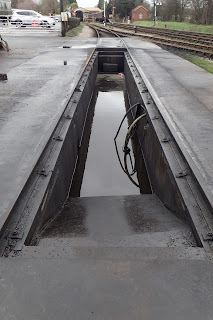The winter maintenance schedule is now progressing well, with all resident home fleet locos receiving some attention at the weekend. The white board in the mess coach has a long to do list on it, which is slowly but surely shrinking.
Paul was one of a group of 10 or more people who tended to the Planet's favourite Prairie (PFP), 5542 on Saturday. The grate has been replaced with a new front carrier and a cold boiler exam has taken place along with the usual mechanical checks. Her running contract with the GWSR is not far from being over now, yet she was still being lovingly cleaned and polished (including being steam cleaned underneath where it doesn't show).
 |
| The PFP receives some TLC (photo courtesy of Paul Richardson) |
 |
| Not usually anywhere near as clean in here (photo courtesy of Paul Richardson) |
 |
| Dan having cleaned the tool box (photo courtesy of Paul Richardson) |
 |
| Brian guards the newly arrived wheels (photo courtesy of Paul Richardson) |
 |
| The fork lift truck was used to turn it the right way round (photo courtesy of Paul Richardson) |
 |
| Freshly primed wheels |
 |
| 2807 and the pony truck |
 |
| An inverted axle box with the new under keep casting in place |
 |
| Just for good measure, here is the other one |
 |
| Trolley jack in place, that should do the trick! |
 |
| Extracting one of the brake pins |
 |
| The bubble, 55003. |
 |
| Mark stripping down the safety valves prior to the annual exam (photo courtesy of Mike Solloway) |
 |
| Nigel paints the front buffer beam (photo courtesy of Mike Solloway) |
 |
| Roger was keen enough to help clean Dinmore Manor on Sunday as well as Saturday |
 |
| 7820's coupling rods with bearings removed for checking/replacement |
 |
| Three of Swindon's finest (l-r) 5542, 7820 & 4270 |
 |
| 4270 with the freight train during the 2014 gala |







































